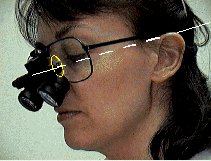

![]()
The degree to which the eyes will be declined (i.e., inclined downward) as a surgeon views the surgical site is the Declination Angle.
![]()
 Technically speaking, the
optical declination angle is defined as the angle between the support line of an
operator’s spectacles-mounted system and the actual line of sight chosen by the
operator. The reference support line for an operator’s spectacles-mounted system is
identified as the SAC-Bridge of Nose Line.
Technically speaking, the
optical declination angle is defined as the angle between the support line of an
operator’s spectacles-mounted system and the actual line of sight chosen by the
operator. The reference support line for an operator’s spectacles-mounted system is
identified as the SAC-Bridge of Nose Line.
![]()
 SAC
is an abbreviation for the Superior Auricular Crevice, where the temple piece of
spectacles rests on the ear. The bridge of the nose for purposes of this reference is the
weight-bearing part of the nose which supports the nose pads of the spectacles. This same
reference is used for headband-mounted telescope systems or loupes, even though they do
not bear upon the nose.
SAC
is an abbreviation for the Superior Auricular Crevice, where the temple piece of
spectacles rests on the ear. The bridge of the nose for purposes of this reference is the
weight-bearing part of the nose which supports the nose pads of the spectacles. This same
reference is used for headband-mounted telescope systems or loupes, even though they do
not bear upon the nose.
![]()
The surgeon's ideal declination angle is based upon musculoskeletal requirements which are unique to the surgeon and also upon certain limitations of the operating settings (although these limitations may be as much based on habits as they are on settings).
The telescope's ideal declination angle is one that is exactly matched to the surgeon's ideal declination angle. Otherwise, the surgeon will be forced to compromise to serve the equipment.
If the declination angle of the telescope is less than or greater than the surgeon's ideal declination angle, the surgeon will have to tip the head downward in order to view the surgical site. This introduces the risk of neck strain and/or back strain, and an attendant increased likelihood of RSIs and ASTDs.
![]()
Any surgeon who suffers back, neck, and/or shoulder pain should seriously consider inappropriate Declination Angle of his magnification system among the potential causes.
![]()
Research shows that ideal declination angles among surgeons ranges from 15° to 44°, with a mean of 34°. However, each surgeon has a specific optimal declination angle. What is most important to you, however, is to determine your ideal declination angle?
Most fixed (through-the-lens) telescopes can achieve up to 45°, although until recently manufacturers set the declination angles between 10° and 22°. Many adjustable telescopes (flip-ups) are unable to achieve greater than 34° declination.
![]()
In general, the further an operator is forced to tip the head forward and downward in order to see through telescopes, the greater the risk of strain to musculature of the head, neck and shoulder areas.
On the other hand, most operators will prefer a certain degree of forward and downward tipping of the head in order to minimize the strain on the intrinsic and extrinsic eye musculature which is attendant to any extreme downward casting of the eyes.
![]()
Remember: The optimal Declination Angle represents a balance between the extremes of eyestrain (when there is too little downward tipping of the head) and neck strain (when there is too little declination of the eyes). This balance is critical.
![]()
If you have comments or suggestions,
![]()
This page created with Netscape Navigator Gold